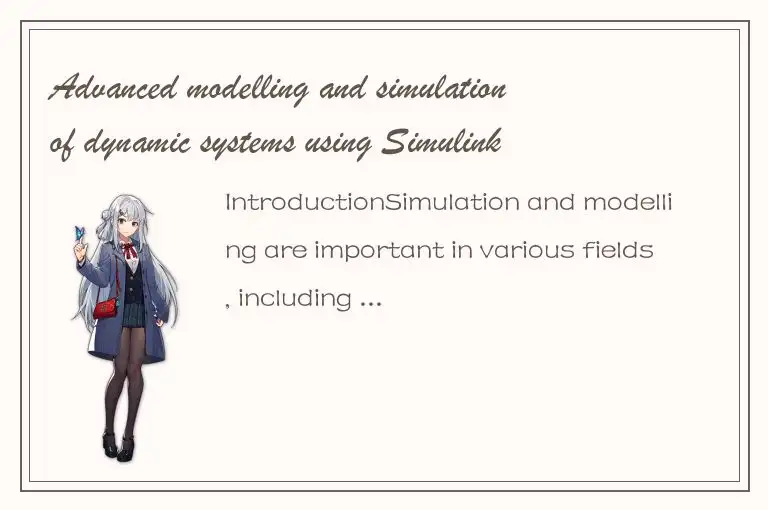Introduction

Simulation and modelling are important in various fields, including engineering, physics, and biology. For instance, dynamic systems in engineering and physics require modelling and simulation to understand their behaviour and functionality. Simulink is a computational tool that provides a platform for modelling and simulation of dynamic systems. This paper discusses advanced modelling and simulation of dynamic systems using Simulink.
Overview of Simulink
Simulink is a computational tool developed by Mathworks to model and simulate dynamic systems. It provides a visual interface for designing models that consist of blocks and lines. The blocks represent mathematical operations, while the lines represent signals or connections between the blocks. Simulink generates code that can be simulated and analysed using Matlab. Simulink has various features that enable effective modelling and simulation of dynamic systems, including:
1. Model-Based Design
Simulink provides a platform for model-based design, which allows designers to develop and test models before implementing them in actual hardware. This approach saves time and money in the design process and increases the reliability of the final product.
2. Library of Blocks
Simulink provides a library of pre-built blocks that represent various physical and mathematical operations. These blocks can be customized and combined to create complex models.
3. Reliable Simulation
Simulink uses numerical solvers to simulate models accurately, enabling designers to investigate the behaviour of systems under different conditions.
4. Code Generation
Simulink generates code that can be used for embedded systems or hardware-in-the-loop (HIL) testing. This feature allows designers to test and verify models in a real-time environment.
Advanced Modelling and Simulation in Simulink
Simulink provides tools and features that enable advanced modelling and simulation of dynamic systems. These tools include:
1. Nonlinear Modelling
Simulink allows designers to model nonlinear systems using various techniques, including linearization, piecewise linear approximation, and state-space representation. Nonlinear modelling is essential for understanding complex systems that exhibit nonlinear behaviour, such as chaos and bifurcation.
2. Signal Processing
Simulink provides tools for designing and simulating signal processing systems, such as filters, samplers, and quantizers. These tools are important in various fields, including communications and control systems.
3. Control Systems
Simulink provides tools for designing and simulating feedback control systems, such as proportional-integral-derivative (PID) controllers and state feedback controllers. These tools are important in various engineering applications, including aerospace, automotive, and robotics.
4. Embedded Systems
Simulink provides tools for generating code for embedded systems, such as microprocessors and field-programmable gate arrays (FPGA). These tools facilitate the implementation of models in actual hardware, enabling designers to test and verify the functionality of systems.
Example: Modelling and Simulation of a DC Motor
To demonstrate the use of Simulink in advanced modelling and simulation, consider the modelling and simulation of a DC motor. A DC motor consists of a rotor and a stator, with mechanical and electrical components. The system can be modelled as a set of differential equations, representing the dynamics of the motor.
The Simulink model of the DC motor can be constructed using various components available in the Simulink library. The mechanical system can be modelled using the integrator and gain blocks, while the electrical system can be modelled using the inductor and resistor blocks. The model can be simulated using the Simulink solver, providing a visualisation of the behaviour of the motor.
Conclusion
Simulink is a powerful computational tool for modelling and simulating dynamic systems. It provides a visual interface for designing models, a reliable simulation engine, and various advanced features for modelling complex systems. Simulink is widely used in various fields, including engineering, physics, and biology. The use of Simulink in advanced modelling and simulation enables designers to understand complex systems and develop reliable products.




 QQ客服专员
QQ客服专员 电话客服专员
电话客服专员